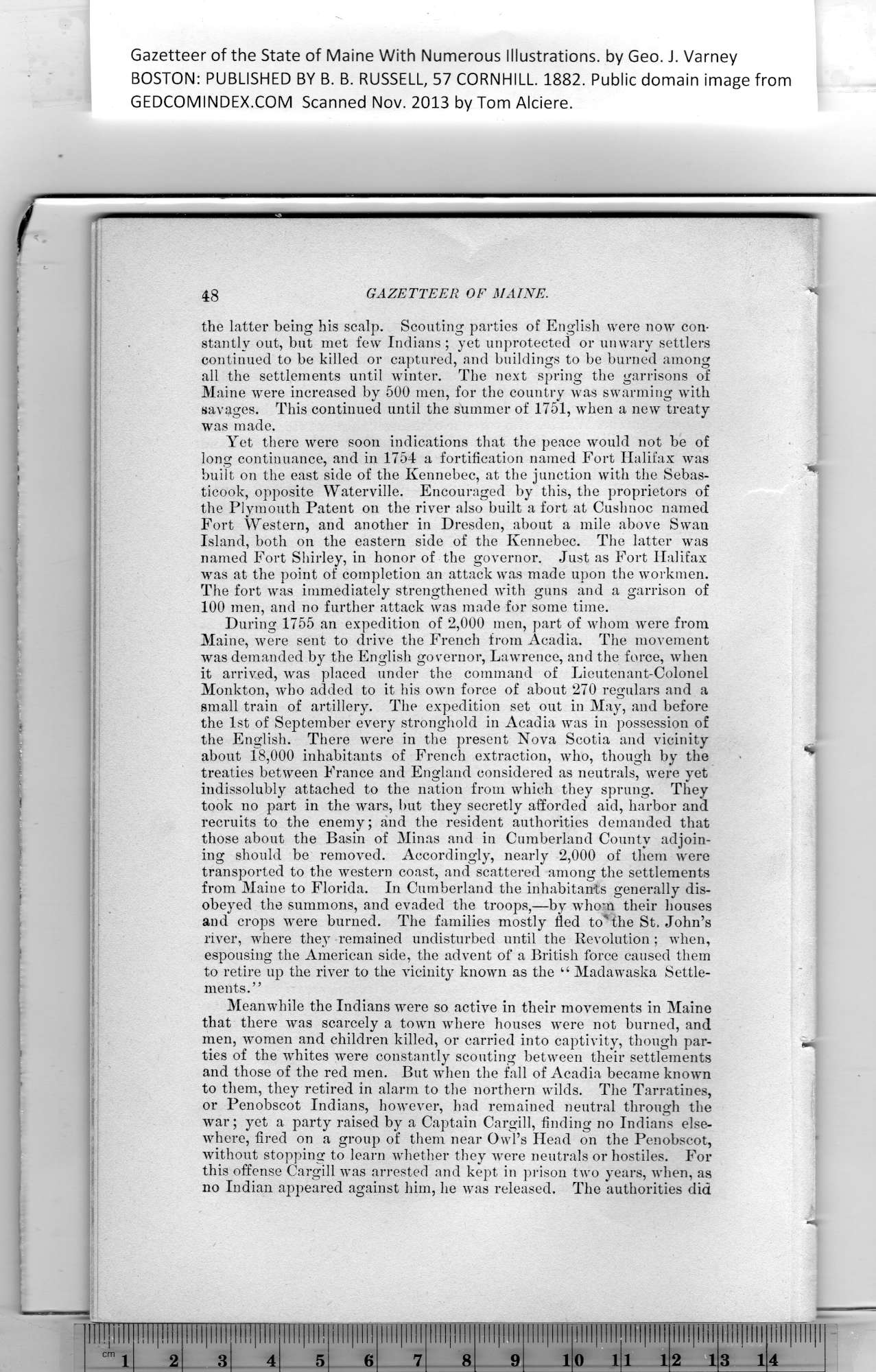|
Gazetteer of the State of Maine With Numerous Illustrations, by Geo. J. Varney
BOSTON: PUBLISHED BY B. B. RUSSELL, 57 CORNHILL. 1882. Public domain image from
48 GAZETTEER OF MAINE.
the latter being his scalp. Scouting parties of English were now con-
stantly out, but met few Indians ; yet unprotected or unwary settlers
continued to he killed or captured, and buildings to be burned among
all the settlements until winter. The next spring the garrisons of
Maine were increased by 500 men, for the country was swarming with
savages. This continued until the summer of 1751, when a new treaty
was made.
Yet there were soon indications that the peace would not he of
long continuance, and in 1754 a fortification named Fort Halifax was
built on the east side of the Kennebec, at the junction with the Sebas-
ticook, opposite Waterville. Encouraged by this, the proprietors of
the Plymouth Patent on the river also built a fort at Cushnoc named
Fort Western, and another in Dresden, about a mile above Swan
Island, both on the eastern side of the Kennebec. The latter was
named Fort Shirley, in honor of the governor. Just as Fort Halifax
was at the point of completion an attack was made upon the workmen.
The fort was immediately strengthened with guns and a garrison of
100 men, and no further attack was made for some time.
During 1755 an expedition of 2,000 men, part of whom were from
Maine, were sent to drive the French from Acadia. The movement
was demanded by the English governor, Lawrence, and the force, when
it arrived, was placed under the command of Lieutenant-Colonel
Monkton, who added to it his own force of about 270 regulars and a
small train of artillery. The expedition set out in May, and before
the 1st of September every stronghold in Acadia was in possession of
the English. There were in the present Nova Scotia and vicinity
about 18,000 inhabitants of French extraction, who, though by the
treaties between France and England considered as neutrals, were yet
indissolubly attached to the nation from which they sprung. They
took no part in the wars, but they secretly afforded aid, harbor and
recruits to the enemy; and the resident authorities demanded that
those about the Basin of Minas and in Cumberland County adjoin-
ing should be removed. Accordingly, nearly 2,000 of them were
transported to the western coast, and scattered among the settlements
from Maine to Florida. In Cumberland the inhabitants generally dis-
obeyed the summons, and evaded the troops,—by whom their houses
and crops were burned. The families mostly fled to the St. John’s
river, where they remained undisturbed until the Revolution ; when,
espousing the American side, the advent of a British force caused them
to retire up the river to the vicinity known as the “ Madawaska Settle-
ments.”
Meanwhile the Indians were so active in their movements in Maine
that there was scarcely a town where houses were not burned, and
men, women and children killed, or carried into captivity, though par-
ties of the whites were constantly scouting between their settlements
and those of the red men. But when the fall of Acadia became known
to them, they retired in alarm to the northern wilds. The Tarratines,
or Penobscot Indians, however, had remained neutral through the
war; yet a party raised by a Captain Cargill, finding no Indians else-
where, fired on a group of them near Owl’s Head on the Penobscot,
without stopping to learn whether they were neutrals or hostiles. For
this offense Cargill was arrested and kept in prison two years, when, as
no Indian appeared against him, he was released. The authorities did
PREVIOUS PAGE ... NEXT PAGE
This page was written in HTML using a program written in Python 3.2
|
